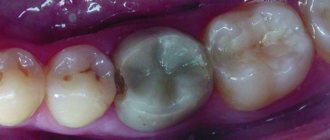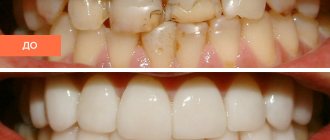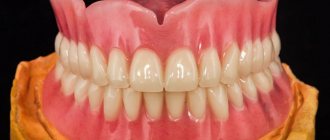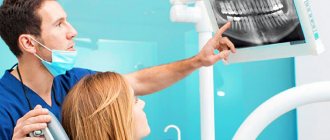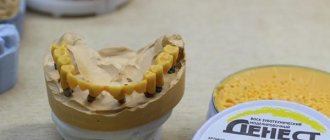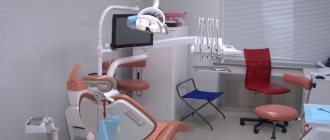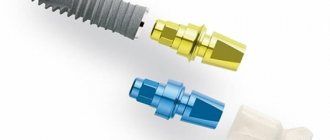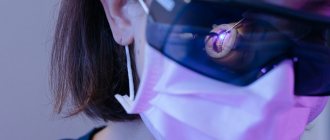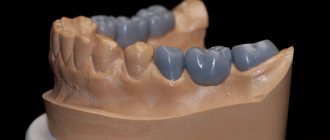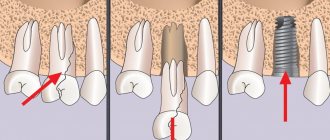Have you decided to install veneers or crowns, but have doubts about the ideality of the final result? Then use the wax modeling service and visually evaluate the beauty of your future smile, even before the manufacture and installation of a permanent denture.
Using innovative Wax-up and Mock-up technologies, dental laboratory specialists will create an accurate mock-up of a permanent structure and demonstrate its convenience to the patient. If necessary, technical adjustments will be made to correct the shape and size of individual teeth. And only after this, in accordance with the planned plan, the final version of the implants will be manufactured.
Wax-up technology
Wax-up is an indirect diagnostic modeling of dental implants. This is the initial stage of work, which allows you to clearly demonstrate the aesthetic perfection of the future prosthetic structure.
Wax-up modeling steps include:
- Taking impressions of the upper and lower jaw using silicone.
- Processing of a silicone blank in an articulator, a mechanical device that allows you to reproduce the movements of the lower jaw.
- Analysis of the obtained data and their correction.
- Making a wax model using a silicone blank, ready for demonstration to the patient.
Material requirements
To make impressions and make a model, wax mixtures of the first and second types are used. The first is used for direct techniques, the second for indirect ones. Type I materials are of high quality and are preferred when performing modeling in the oral cavity.
There are several key rules for using and selecting mixtures:
- to make the design more contrasting and visual, it is better to use mixtures of bright colors, for example, blue or red;
- after cooling, the properly prepared mass does not crumble, but retains the rigidity and integrity of the structure;
- when heating, it is necessary to ensure that there are no crumbs or foreign inclusions in the mass, which negatively affect the quality and accuracy of the future model;
- When scraping, the formation of flakes and crumbs is not allowed;
- Wax should be stored in accordance with the manufacturer's recommendations.
Preparation and stages of the procedure
Before you begin prosthetics, you must go through a preparation procedure. In this case, wax modeling is the initial stage, in which the following steps must be performed:
- examination of bone tissue, teeth, analysis of the information received;
- sanitation, elimination of caries and other problems;
- therapy if examination reveals periodontitis.
Only after removing obstacles can the modeling procedure begin. Most often, the direct method is chosen, requiring the following steps:
- treating the surface of the tooth that is to be restored, covering it with cotton rolls and drying the enamel;
- the wax is heated and then pressed tightly into the spoon, leaving no cavities;
- after the wax hardens, its excess is removed with wire, which is necessary to remove the model;
- the ends of the pin wire are heated, inserted into the model, after which support is placed on the adjacent teeth with the ones being restored, this helps to avoid vibrations and errors;
- the structure is removed after the material has hardened.
The model is then used to make a prosthesis and further treatment.
Prices
The cost of the procedure is affordable, depending on the materials and methods used. On average, it costs 1100-2700 rubles to make a model of one tooth. To make a calculation, it is recommended to make an appointment and go through the preliminary examination procedure.
About Us
My Ort Clinic offers prosthetic services using various technologies, including wax modeling of teeth. Doctors will carry out preparatory work and a full diagnostic examination to select a suitable design.
Patients are offered the following benefits:
- qualified doctors;
- modern equipment, including diagnostic equipment;
- high-quality materials certified in the Russian Federation;
- favorable prices for services;
- guarantee of reliability and quality.
To make an appointment, please contact us by phone +7 (812) 454-45-50 or leave a request on the website. You can also ask questions by sending a request to the clinic’s email [email protected]
Mock-up technology
This term refers to the direct modeling of a silicone prosthesis directly in the oral cavity. The stages of this process are:
- making a silicone impression of teeth,
- placing composite plastic in it,
- Trying on an impression on the jaw.
After this, the template is covered in layers with enamel, which forms an anatomical model of the teeth. The finished model is installed in the patient’s oral cavity for a tactile sensation of the future denture, and to study the reaction to a foreign body by the mandibular joint.
Indications
The main indications for wax modeling are:
- performing indirect prosthetics;
- restoration of aesthetics;
- production of structures such as lumineers, veneers, bridges or conventional crowns;
- excessive abrasion of enamel;
- anatomical features of the jaw that require detailed modeling;
- destruction of the supra-root area, especially with advanced caries;
- the enamel has acquired a yellowed or brown color that cannot be removed using standard methods;
- restoration of a lost tooth with a preserved root;
- other defects that require correction with a crown or bridge.
The procedure has a number of contraindications, including:
- allergic reactions to the materials used when taking impressions;
- acute oral diseases;
- rehabilitation after radiation therapy;
- malignant formations;
- drug addiction, alcohol abuse, smoking;
- bone diseases;
- inflammatory processes of the mucous membrane in the acute stage;
- other diseases that may become an obstacle to prosthetics.
Making a wax model takes about 20 minutes, that is, the manufacture of the device is carried out immediately in the presence of the Patient. This allows you to immediately show the expected future result.
When is it necessary to use Wax-up and Mock-up modeling technologies?
Preliminary wax modeling is recommended for patients who have increased tooth wear or problems with the jaw joints. Also, a wax model is indispensable when carrying out large-scale prosthetics. It will help eliminate all shortcomings at the initial stage and relieve the patient from subsequent discomfort when using the prosthesis. It will allow you to clearly demonstrate the aesthetic perfection of the future dental implant.
Methods
The following techniques are used for dental wax modeling:
- direct with making an impression in the Patient’s mouth;
- indirect, requiring preliminary production of a plaster product; it takes less time, but there are some features of the procedure.
Each method has its own pros and cons:
- the indirect method is more convenient for the Patient, since the time spent in the chair is reduced, in addition, the edges of the product can be processed more accurately;
- with the direct method it is better to produce single models;
- the indirect technique is recommended for hard-to-reach areas.
General overview
The Wax up procedure is a wax modeling of teeth using the material of the same name. The finished impression obtained as a result of medical manipulations is used to create temporary prostheses or crowns, and serves as the basis for the development of permanent replacement structures. To create it, liquid wax is used, after which the dentist has the opportunity to visually evaluate the accuracy of the occlusal relationship and the distribution characteristics of the chewing load, as well as clarify with the patient the comfort of sensations from the formed crown. The data obtained forms the basis for further prosthetic processes.
Wax modeling technique
The implementation of the technique includes 3 stages:
- Assessment of the condition of the oral cavity. At this stage, additional diagnostics can be carried out, for example, an orthopantogram, and treatment of various diseases (periodontitis, dental caries, etc.). Modeling is possible only after complete sanitation of the oral cavity.
- Making dental impressions. To do this, the patient needs to bite down on a dental tray made of silicone material.
- Based on the copies received, the dental technician creates copies of the patient’s jaws in the laboratory, after which the final result of the planned treatment is simulated.
An opportunity to look into the future!
If the patient likes the smile he “tried on,” we can begin making permanent aesthetic restorations.
But if you need time to think and consult, then the decision about prosthetics can be postponed, since “trying on” a smile does not require dental treatment.
Now you know how to look into the future , and even before the start of prosthetics, know exactly what your “new” smile will look like.
Come to Nord Dental for the smile of your dreams!
Benefits of dental modeling
Dental prosthetics using modeling has many advantages:
- • provides the patient with a visual model of the final result;
- • eliminates any defects at the initial stages;
- • relieves discomfort in the future;
- • reduces the duration of addiction;
- • does not damage nearby teeth;
- • eliminates misunderstandings that may arise between the patient and the doctor regarding the shape and other features of the teeth;
- • allows you to take into account all the client’s wishes;
- • provides the opportunity to adjust the model.
Models will help improve the effectiveness of dental restoration only if done well. Our clinic employs highly qualified dentists and uses modern equipment, which guarantees high quality service. We will help you fully restore the functionality and aesthetics of your teeth.
Computer design of a “new” smile
A modern dentist is not only a photographer, but also a designer.
To make a smile beautiful and harmonious, the doctor must take into account many nuances, which we describe in detail in the article There are more and more beautiful smiles.
Watch how, using the Digital Smile Design program, the doctor analyzes the proportions of the face, adjusts the size and shape of the teeth so that the “new” smile looks beautiful and harmonious.
Computer modeling allows the doctor, together with the patient, to evaluate several smile options and choose the most suitable one.
The next stage: making models of teeth, and then trying on a “new” smile.
There are two options for obtaining dental impressions
The future of the “new” teeth depends on the accuracy of the impression.
Until recently, impression compounds were used to obtain impressions.
Taking impressions can be uncomfortable and cause a gag reflex in patients, and requires great skill from the doctor, otherwise the impression will be inaccurate.
It happens that casts have to be redone several times.
There is another option: you can get a digital impression of your teeth using an intraoral scanner.
Taking a digital impression is comfortable for the patient , and in terms of accuracy, the scanner is not inferior to impressions taken using impression compounds.
Have you noticed that in the video shown, after taking a digital impression, “some kind of magic” begins... and then the doctor installs a ready-made crown for the patient.
Digital scanning of teeth opens up new opportunities for modeling and manufacturing of orthopedic structures.
Let's compare how further work on creating a smile is built if dental impressions are taken using the “classical” method and using an intraoral scanner.
Teeth modeling methods
- indirect (wax-up) - diagnostic wax modeling; - direct (mock-up) - trying on a prototype of teeth (translated from English as “life-size model”).
Indirect modeling steps
First, the dentist takes impressions of the upper and lower jaws.
In this case, silicone is used, since it is very important that the material is of high quality. Then the doctor records the habitual closure of the jaws, preparing the bite ridges, and performs registration using a face bow. The next stage is work in the articulator. This is the name of a special device that allows you to simulate the movement of the lower jaw and debug all chewing movements of the dental apparatus. If the bite decreases, then with the help of special studies, taking into account facial characteristics, they calculate how many millimeters it needs to be raised.
A silicone model of teeth is placed on a plaster base in an articulator and analyzed. At the same time, the dental technician takes into account the functional and aesthetic wishes of the patient and the dentist. He then makes a wax model and shows it to the patient. If necessary, correction is made.
If the patient is satisfied with everything, then a permanent prosthesis is made in the laboratory based on the Wax-up model.
How does forward modeling work?
Mock-up modeling is performed directly in the oral cavity.
It allows you to determine the optimal shape of the prosthesis. Direct modeling can be figuratively compared to trying on a dress. The doctor makes silicone impressions of the teeth. Great importance should be paid to modeling the palatal surface, without which it will not be possible to make a full-fledged cast.
Composite plastic is placed into the silicone impression (it is better to use a material that is different in color from the teeth) and placed on the patient’s teeth. The impression is then removed and excess materials are removed from it. If necessary, increase the size of the teeth and reduce the width of the spaces between them.
Next, the dentist, using special brushes and prophylactic paste, cleans the teeth of plaque. At the same time, no manipulations are performed with the teeth: they are not prepared or sawed, as with conventional prosthetics, which allows maintaining the integrity of the dental apparatus.
The base shade of enamel and layer-by-layer dentine are applied to the template. Next, the doctor restores the structure of the tooth, forming anatomical details on the surface of the model, including mamelons (the so-called protrusions and tubercles on the teeth). Restoration of the dental structure is carried out sequentially, starting from the oral surface and gradually moving to the vestibular surface. Finally, an enamel shade application is made.
Mechanical finishing is carried out after the surface of the model has dried. If the model is even a little wet, it will be difficult to visually control the quality of grinding. Polish the surface carefully using special silicone heads of different shapes. In this case, their rotation frequency should be low.
The teeth are treated with a special fixing glue and the prepared model is attached to them.
The patient can walk around with temporary teeth, which will allow him to observe his sensations and determine what exactly needs to be corrected. The doctor will also have the opportunity to study the reaction of the mandibular joint.
The technician can produce several models so that the client can make the best choice.
If the patient no longer has any complaints, then the resulting model is sent to the laboratory, where permanent dentures are made based on it.
It is especially recommended to use Mock-up models for patients who need to improve their bite, as well as for those whose teeth are severely worn out. The models are also irreplaceable when performing prosthetics on implants.
Price
Installing an implant system using wax modeling techniques is quite an expensive service. It includes not only the cost of the materials used and special equipment and tools, but also the increased professionalism of the specialist. Thus, in the best dental laboratories in Moscow, the cost of services for modeling one denture starts from 1,500 rubles in Moscow, and outside of it from 600 rubles.
The price may vary depending on the complexity and number of dentition units modeled. The final cost for wax reproduction is calculated by a specialist after diagnosis.
Preparing for wax modeling
Before you begin the process of modeling your future smile, you need to follow a number of recommendations:
- diagnose the mouth;
- if necessary, do a computed tomography scan and x-ray of the jaw;
- for diseases of the oral cavity, undergo a course of treatment;
- observe the rules of hygiene and sanitize the oral cavity.
Also read: Metal-free crown based on zirconium dioxide: its pros and cons
Only after a complete examination and treatment course can the orthodontist and technician begin to create a Hollywood smile.
